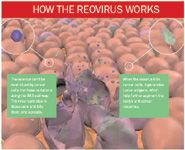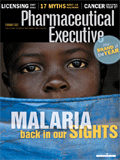Virus as Viable Drug
A lot of the viruses that are being worked on today are genetically engineered to target the cell and crank out a drug that will kill it. But in our case, we don’t need a drug-the reovirus does it all by itself.
When it comes to specialty drugs, there's no hotter area than oncology. For the last few years, much of the interesting science has been focused on targeted therapies, like Avastin (bevacizumab) or Gleevec (imatinib). These drugs are engineered to target specific molecules and pathways, and change the course of cancer cell growth.

Bradley Thompson, CEO of Oncolytics Biotech
But what about the next wave of science? At least for one company, it started back in 1983 at the University of Calgary. Three lab researchers discovered a virus that was able to kill cancer cells that had a particular pathway activated. They watched in amazement: The virus infected malignant tumors, replicated itself, and killed carcinogenic cells—and didn't stop killing until the cancer was gone.
In 1998, those researchers approached Bradley Thompson, a 20-year biotech veteran with a strong sense of humor—particularly given his early training as a microbiologist. At the time, he was working as the chairman and CEO of the small Canadian company Synsorb. A friend called him and asked him if he could advise the Calgary researchers. Thompson invited them in, and recalls the conclusion to the six-hour presentation.

Blame Canada
"They said, 'Could you help us? We're cute scientists, and we don't have a clue about business, and you used to be a cute scientist, and you've gone to the dark side.' That's pretty close to how the conversation went."
Thompson could hardly refuse. He found the science impressive; the animal models, impeccable. Thompson also says the research reached him at a susceptible time in his life: In the span of 180 days, his mother and favorite uncle had died of cancer, and he had undergone major surgery to remove a melanoma from his leg. In 1999, Thompson formed Oncolytics Biotech based on the idea that it could turn this virus, called the reovirus, into a drug.
Thompson confesses that the science behind the virus (branded Reolysin) may seem "wonky," and indeed, for many in the industry, the concept of Oncolytics' therapy is hard to grasp. After all, researchers have become familiar with the complex engineering of adenoviruses and other vectors to carry a specific tumor-fighting gene—but many had never considered releasing the virus to attack cancer cells on its own.
However, the evidence is slowly mounting and skeptics are climbing on board. The US National Cancer Institute is paying to test the drug on patients with melanoma and ovarian cancer, and the company recently received approval to expand its trials in the United Kingdom.

How the Reovirus Works
Here, Brad Thompson talks to Pharm Exec about how the company got its start, and the virus that he thinks will change cancer care forever.
Where did the idea of using viruses to treat cancer originate?
It's an area of interest now, so there's a lot of dispute about who exactly discovered this. Of course, when something works, everybody then lays claim—success has many mothers, failure is an orphan.
But looking back, every five or so years dating back to the 1800s, there have been reports in the medical literature of patients with terminal cancer coming down with a mild flu-like illness and miraculously recovering from their cancer. Sometime during the 1960s, somebody said, "Oh wait, what causes mild flu-like symptoms? Flu or flu-like organisms, which are viruses." And so people started looking around for various naturally occurring viruses that might cause cancers to regress. That's where the whole field was born—and since then, there's been this sequence of almost accidental discoveries leading to different viruses being tested to treat cancers.
How does this oncology therapy distinguish itself from other viruses used on the market today?
A lot of the viruses that are being worked on today are genetically engineered to target the cell and crank out a drug that will kill it. But in our case, we don't need a drug—this reovirus just does it all by itself. This is targeted therapy handed to you by Mother Nature.
What exactly is a reovirus?
Reovirus is an acronym for respiratory enteric orphan virus. Reovirus is, if not the most common environmental virus, one of the most common. It is found naturally in sewage and water supplies. But if you have ever walked through wet soil, you might have exposed yourself to it. By age 21, anywhere between 70 and 100 percent of the adult population will have been infected with a reovirus sometime in their life.
It infects the lining of the lungs and the bowels of all mammals. But it doesn't cause disease. The time it takes for the virus to kill those cells is the same time those cells are programmed to die anyway. The lining of your lungs sloughs regularly because it's constantly assaulted by oxygen, and so it's programmed to die and you get new cells. Your bowels are programmed to die because they're exposed to every nasty toxin that your body's trying to get rid of that doesn't go out in your urine. They slough off in the same way.
If the reovirus is that common, why have so few people heard of it?
Who studies a virus that doesn't cause a disease? The ones we've studied are the ones that are important to us medically, which until now have been negative. But actually, most viruses don't cause disease. Viruses that kill people are the environmental anomalies, not the other way around.
How does Reolysin work as a cancer tretment?
The reovirus needs the RAS pathway to be turned on to replicate. And turned on RAS pathways are most commonly found in cancer cells. In fact, about two-thirds of all cancers have an activated RAS pathway. It's a very common target. If you look at the aggressive cancers, pancreatic cancer is virtually 100 percent RAS-activated. Brain cancers, melanomas, the skin cancers—almost all metastatic disease—are all between 90 and 100 percent RAS-activated.
If the reovirus goes into a cell where the RAS pathway isn't activated, nothing happens. The cells have natural antiviral pathways and the virus just gets chewed up by the cell enzymes. If the virus goes into a cell that has a RAS-activated pathway, that's an enabling condition for it to grow. Every cell that it infects will break open when it dies, and infect the tissue around it and produce anywhere between 5,000 and 40,000 progeny virus particles. Those will replicate, and it'll kill the tumor within three days.
After the virus invades, the immune system also helps kill tumors. It's a one-two punch.
How accepted is the idea of ingesting a virus?
I'm a microbiologist, so I know virology really well. That part of it didn't bother me, which as it turns out, is the part that bothered most people. Infecting a sick or dying person with a virus, no matter how benign, has been the question with this drug.
As it turns out, that's not an issue. We've treated about 110 patients now, and half the patients have no side effects and the other half get a degree of fever, or they're tired or get muscle pain for a day. Compared to what you get with old-line chemotherapy or radiation or surgery, it's nothing. The alternatives are a lot more aggressive than not feeling up to snuff for a day or so.
What was your biggest concern with taking on such early science?
Most virus products fail, not because they don't work. Actually, virtually all of them are active. They fail because you can't make them.
It's like the Taxol problem. There weren't enough Pacific Yew trees in the world to generate enough Taxol to treat patients. It worked, but until they had a synthetic process to make Taxol in bulk, it had no future as a product. But now we know how to produce it.
Oncoloytics' Phase I clinical program lasted for three years. Why so long?
For two reasons. The product is so active that we needed a more comprehensive understanding of its activity in a Phase I environment. We've seen clinical responses in patients with prostate, breast, lung, liver, head and neck, esophageal, melanoma, and pancreatic cancers. That has given us a lot of confidence going into Phase II. Secondly, we wanted to show, above and beyond, that it was safe.
We also wrestled with the issue of staged timing. That's where in Phase I, you infect somebody with the virus, and then you wait a period of time to ensure that there's no safety issues before you move to the next patient cohort.
We don't want a repeat of the TeGenero study last spring in the United Kingdom, where they treated six patients in the same hour in the same room, and had the placebo patients watch the treated patients all inflate like little balloons and almost die in front of their eyes. That would never happen on a reovirus study because we properly space the dosing of patients.
Our radiation study [which treated patients in combination with Reolysin] was approved about six weeks after that whole issue blew up in the United Kingdom. The Medicines and Healthcare Products Regulatory Agency just sent it back and said, "It's approved" —and that's when they were in the middle of the firestorm of answering the question "Was it your fault?" That's because we do things the way they want us to and the way it's supposed to be done. That's why it has been slow.
How safe is this approach?
There's probably 6,000 or 7,000 patients that have been treated with gene therapy for oncology or virology, but there's been less than 10 serious adverse events. And they're usually patients who shouldn't have been in the study in the first place.
The bubble kids in France should not have gotten gene therapy, period. We know that now. Jesse Gelsinger [who died at the University of Pennsylvania in 1999 after receiving gene therapy] should not have been enrolled in that study with adenoviruses because he had a liver issue, and adenoviruses are liver toxic.
So the serious adverse events are explainable, but it's the lowest serious side effect profile of any new drug class ever with that many patients.
The reovirus is, in essence, a platform drug. How do you decide which indication to go after?
Until now, we've been positioned as the "two-thirds of all human cancers company." But this year, Oncolytics will run eight Phase II studies of different drug and radiation combinations to identify specific cancers to go after.
We recently announced a combination study in the United Kingdom with [Lilly's] Gemzar (gemcitabine) for lung and pancreatic cancer patients. So we'll be the lung and pancreatic cancer company if we focus on the Gemzar combination. Or the head and neck, esophageal, or B-cell lymphoma company if we carry on with radiation studies. We can then generate the numbers that will tell us which pivotal studies are the most compelling.
What are the biggest challenges you face going into Phase II?
We're going to be enrolling more patients in 2007 than we've enrolled in the last six years total. And in 2008, again we'll be enrolling more patients than we've enrolled up to that date. For now, it's a clinical management issue. Instead of having two or three sites running clinical studies, we're going to have 40 or 50.
How do you think virus research is changing the understanding of human disease?
You're going to find viruses and bacteria have links with a great number of diseases. Just look at Gardasil, which is now about to become a multibillion dollar drug to vaccinate people against cervical cancer. It's going to eliminate virtually all cervical cancers. I think we will also find that inflammation is probably triggered by a lot of things, including bacterial and viral infections.
Are there other viruses that work as drugs?
There's hundreds of them. The reovirus is just the tip of the iceberg when it comes to benign viruses.
Some people are doing research on other natural oncolytic viruses. The Newcastle virus has been under investigation since the '60s. Nobody really knows how Newcastle works, but it's kind of a cult virus. There are clinics in Germany that import it illegally from Hungary—but it has problems because of that.
There's also a group in Japan that is researching co-therapy with reovirus in animal models. Now, there is no regulatory agency on this planet today that will allow you to simultaneously infect a human being with two viruses in a clinical trial, until one or the other or both are approved. But it'll happen.
Oncolytics went public early. Why?
Canadian companies don't really have a venture capital community or a private equity community. And so Canadian companies typically do a small round or two and go public way too early, and we were like that too. In Canada, the only way to raise money is to be a public company. If I had my druthers, we'd be going public now, not six years ago.
But that's just because of the state of the market in Canada. In the US market, companies can stay private a lot longer because there's private equity and other sources that will encourage that, and you to focus on your business rather than going public.
And now that you can increasingly sell biotechs to bigger audiences, like big and medium pharma, you're starting to see a slight shift toward staying private. Companies will stay private so they can get a better evaluation, and don't have to go through the hassles and expense of being a public company, which are increasingly a burden.
At this point, does the company still need to raise capital?
Oh, endlessly. That's biotech. Biotech has perfected the art of spending money more efficiently than any industry on the planet, except possibly the fusion research and the fuel cell research guys.
That's because our business model isn't to become profitable; it's to become partnered or sold. There are outliers—like Amgen—but that's not the business model for the biotech industry.
As Oncolytics goes further along in clinical trials, it becomes more of a target for acquisition. What's your expectation for how the landscape will change?
Lehman Brothers just conducted a study that revealed around an eight percent annual aggregate revenue growth rate for the next 15 years every year for the pharmaceutical industry. To achieve that, Big Pharma has to get a drug approval a week, every week, for 15 years—and sell it for three-quarters of a billion dollars or more a year.
That's impossible with Big Pharma's internal research programs. And it's virtually impossible anyway because the FDA only approves about 25 drugs a year.
But Big Pharma's internal research programs are increasingly looking outside their own internal labs. Now, they've done partnering relationships for a long time, but not necessarily by desire.
There were some exceptions: Roche, for example, which has historically been ahead of the curve, and Johnson & Johnson, which for a long time was very aggressive about partnering. But they were anomalies.
But now Big Pharma is asking if it is cheaper to buy or partner. And increasingly, they are saying it's better to spend an extra couple hundred million today than it is to spend $5 billion five years from now when it's a top-seller and you have to buy them out anyway, which was the old model—partner then buy. In the last year, we've seen buying or partnering, not partnering then buying.
Bradley Thompson is the chairman, CEO, president, and co-founder of Oncolytics Biotech, an Alberta, Canada-based company that is developing an oncovirus as a cancer therapeutic. He held a simlar title at his previous stint at Synsorb Biotech, which developed drugs for infectious diseases and cancer. Throughout his career, Thompson also held positions as the head of program development of the Alberta Research Council and senior biotechnologist at Gemini Biochemical Research. Thompson graduated in 1981 from the University of Western Ontario with a PhD from the department of microbiology and immunology.

Addressing Disparities in Psoriasis Trials: Takeda's Strategies for Inclusivity in Clinical Research
April 14th 2025LaShell Robinson, Head of Global Feasibility and Trial Equity at Takeda, speaks about the company's strategies to engage patients in underrepresented populations in its phase III psoriasis trials.
Key Findings of the NIAGARA and HIMALAYA Trials
November 8th 2024In this episode of the Pharmaceutical Executive podcast, Shubh Goel, head of immuno-oncology, gastrointestinal tumors, US oncology business unit, AstraZeneca, discusses the findings of the NIAGARA trial in bladder cancer and the significance of the five-year overall survival data from the HIMALAYA trial, particularly the long-term efficacy of the STRIDE regimen for unresectable liver cancer.
Expanding Immune Response Testing to Support Vaccine Development
April 22nd 2025Nigel McCracken, chief operating officer, Virax Biolabs, discusses the expansion of its ViraxImmune platform into areas such as transplant monitoring, vaccine efficacy, latent virus reactivation, and CAR T cell therapy.

.png&w=3840&q=75)

.png&w=3840&q=75)



.png&w=3840&q=75)



.png&w=3840&q=75)






















